

กระดาษทรายกับงานไม้ กระดาษทรายกับงานไม้ กระดาษทรายที่ใช้กับงานขัดไม้ ก่อนการทำสี การขัดด้วยกระดาษทราย การขัดไม้ก่อนทำสี จะมีลำดับการทำงานคือ การขัดหยาบ ขัดเรียบ ขัดละเอียด ขัดหยาบ (Leveling) - เป็นการขจัดจุดบกพร่องบนพื้นผิว ลบรอยจากเครื่องจักร/เครื่องมือ ให้ใช้เบอร์ 120 หรือ P120 แต่หากผิวหยาบมาก ก็ให้ใช้ 80 หรือ P80 ก่อน จึงตามด้วย 120 หรือ P120 ขัดเรียบ (Uniforming) - เป็นการลดรอยกระดาษทรายจากขั้นตอนแรก ให้ใช้เบอร์ 180 หรือ P180 สำหรับงานที่ไม่ต้องการความละเอียดมาก ก็สามารถขัดถึงขั้นนี้ แต่หากเป็นงานเฟอร์นิเจอร์ ควรขัดละเอียดต่อไปอีก.
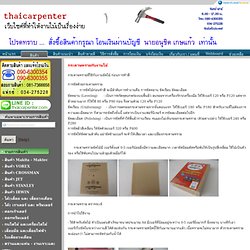
The Chemistry of Soaps. Soaps, Detergents and Cleaning Fats are isolated from plants and animals.
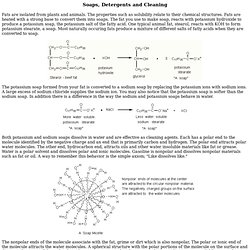
The properties such as solubility relate to their chemical structures. Fats are heated with a strong base to convert them into soaps. The fat you use to make soap, reacts with potassium hydroxide to produce a potassium soap, the potassium salt of the fatty acid. One typical animal fat, stearol, reacts with KOH to form potassium stearate, a soap. The potassium soap formed from your fat is converted to a sodium soap by replacing the potassium ions with sodium ions. Both potassium and sodium soaps dissolve in water and are effective as cleaning agents. The nonpolar ends of the molecule associate with the fat, grime or dirt which is also nonpolar, The polar or ionic end of the molecule attracts the water molecules. Magnesium and calcium salts of the same fatty acids that make up potassium and sodium soaps are not water soluble. How to Create a Faux Driftwood Finish — THAT PainterLady.com. Your ads will be inserted here by Easy AdSense.
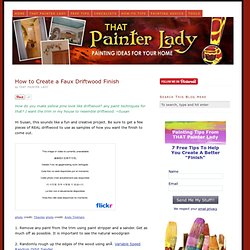
Please go to the plugin admin page toPaste your ad code OR Suppress this ad slot. How do you make yellow pine look like driftwood? Thai architecture. Bardage bois : Quels sont les avantages ? Janka hardness test. The Janka hardness test measures the resistance of a sample of wood to denting and wear.
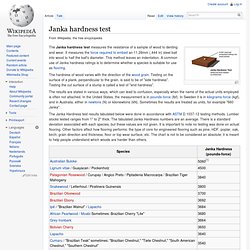
It measures the force required to embed an 11.28mm (.444 in) steel ball into wood to half the ball's diameter. This method leaves an indentation. A common use of Janka hardness ratings is to determine whether a species is suitable for use as flooring. The hardness of wood varies with the direction of the wood grain. Testing on the surface of a plank, perpendicular to the grain, is said to be of "side hardness".
The Janka Hardness test results tabulated below were done in accordance with ASTM D 1037-12 testing methods. References[edit] External links[edit] Material Properties of Teak, Wood Class I (>25y) Class of durability Australia. In general, there are two main factors that influence the durability of timber in service. The first is the natural durability of the particular species. The second is the type and degree of hazard to which the timber is exposed. The natural durability of particular species is expressed as one of four Durability Classes. For each of three different service conditions: * in-ground contact * outside above ground * marine borer resistance These classes are based on field trials of untreated heartwood and indicate the resistance of the heartwood of the species to fungal, insect attack and borer attack.
Grade of wood. VOCS emission. VOCs are numerous, varied, and ubiquitous.

They include both human-made and naturally occurring chemical compounds. Most scents or odours are of VOCs. VOCs play an important role in communication between plants, [1] and messages from plants to animals. Some VOCs are dangerous to human health or cause harm to the environment. German DIN 1 bis DIN 499. Logo des Deutschen Instituts für Normung Die Normenliste DIN 1 bis DIN 499 listet alle aktuellen Normen und viele historische Norm-Ausgaben des Nummernbereichs 1 bis 499.
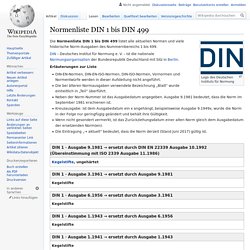
DIN – Deutsches Institut für Normung e. V. – ist die nationale Normungsorganisation der Bundesrepublik Deutschland mit Sitz in Berlin. Erläuterungen zur Liste DIN-EN-Normen, DIN-EN-ISO-Normen, DIN-ISO-Normen, Vornormen und Normentwürfe werden in dieser Aufstellung nicht angeführt.Die bei älteren Normausgaben verwendete Bezeichnung „Blatt“ wurde einheitlich in „Teil“ überführt.Neben der Norm-Nummer ist das Ausgabedatum angegeben. WWA Wood Sampler. Document technique unifié. Un article de Wikipédia, l'encyclopédie libre.

Un document technique unifié (DTU) est un document applicable aux marchés de travaux de bâtiment en France. Il est établi par la « Commission Générale de Normalisation du Bâtiment/DTU » dont le Centre scientifique et technique du bâtiment assure le secrétariat. Composition des DTU[modifier | modifier le code] Un DTU peut se composer des documents suivants : Le cahier des clauses techniques (CCT) qui définit les conditions à respecter dans le choix et la mise en œuvre des matériaux ;Le cahier des clauses spéciales (CCS) qui accompagne le CCT et définit les limites des prestations et obligations envers les autres corps de métier ;Les règles de calcul pour le dimensionnement des ouvrages.
Ces trois types de documents sont d'application contractuelle. Évolution du statut des DTU[modifier | modifier le code] Les DTU sont établis par une instance, appelée à sa création en 1958, Groupe de Coordination des Textes Techniques ou encore Groupe DTU. List of EN standards.